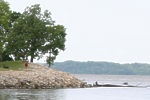YELLOW RIVER STATE FOREST
The Yellow River State Forest, located in Iowa, is a nature lover's paradise encompassing over 8,500 acres of diverse landscapes. Nestled along the meandering Yellow River, this serene forest offers a picturesque haven with its rolling hills, flourishing forests, and sparkling streams. Within its boundaries, visitors can explore an extensive network of hiking trails that wind through stunning bluffs, lush valleys, and enchanting woodlands. Wildlife enthusiasts will be captivated by the abundant flora and fauna, including deer, wild turkeys, and various bird species. With its stunning natural beauty and tranquil ambiance, the Yellow River State Forest is a true escape from the hectic pace of everyday life. Whether you seek adventure, relaxation, or simply an opportunity to reconnect with nature, this forest is a haven worth exploring.
Fauna
Yellow River Forest is home to many species of wildlife who live in its various habitats. From a recreational standpoint, Yellow River Forest presents opportunities for hunters to take deer, squirrel, raccoon and various species of waterfowl and upland game birds; the trapper to harvest beaver, mink and other furbearers and the angler to take trout and other species of gamefish.
The forest has many good opportunities for bird watchers to pursue their interests. Many ducks, wading birds and other marsh dwelling birds occupy the marshes and beaver ponds on Little Paint Creek. Bald eagles may be seen at any time on the forest and surrounding environs. A threatened and endangered bird of the forest is the red-shouldered hawk.
Back to Yellow River Forest by Subject
Flora
The major Yellow River Forest plant communities are maple-basswood, oak-hickory and bottomland hardwoods. Prairie species may be found on dry bluff tops, rock outcroppings and steep slopes that face south and west.
The maple-basswood forest type is commonly found on north and east facing slopes and is largely comprised of sugar maple, basswood, white ash and red and white elm.
The oak-hickory forest type occupies drier sites such as ridge tops and south and west facing slopes. Components include red and white oak, red and white elm, bur oak and hickory.
The bottomland hardwoods forest type includes red and white elm, green ash, cottonwood and several other bottomland species.
Prairie sites contain big and little bluestem, needle-and-thread grass, indiangrass, prickly pear and others. Jeweled shooting star (Dodecatheon amethystinum) is a state endangered species found on the forest.
Many acres have been planted to native hardwoods like black locust and English oak and several species of conifers. Species adaptation plots (trial plantings of conifers) have been established to test the practicability of planting the various species represented.
The first lands acquired for Yellow River State Forest were purchased in 1935 with funds that were appropriated to support the Civilian Conservation Corps (C.C.C.). The original purchase was adjacent to the Yellow River near its confluence with the Mississippi and the name "Yellow River Forest" was appropriate. In 1949, 1500 acres of the Forest was transferred to the National Park Service and became a part of Effigy Mounds National Monument. The larger units of the state forest are now located in the Paint Creek watershed, north of Yellow River. Subsequent land purchases consolidated scattered tracts and today the forest is 8,503 acres in size.
Because most land purchased was farmland and pasture, the early management of Yellow River Forest was concerned with protection from grazing, fire and soil erosion. Timber harvests provided material that the C.C.C. used for construction on state parks and other state areas.
During the 1940s, most of the open land was planted to trees. The plantations of large pines that can be seen on the forest today are the result of these efforts. The extensive system of fire lanes that provided protection to these plantations serves today as part of the recreational trail system for hiking, cross country skiing, horse riding and snowmobiling.
In 1947, a sawmill, which the Forestry Division continues to operate was moved to the Paint Creek Unit from Pikes Peak State Park. All the trees processed at the mill are harvested from state land and the lumber used on state parks and wildlife areas, other DNR areas, sold to other state agencies or sold to private individuals. About $20,000 worth of lumber is transferred each year to units of the DNR and another $10,000 worth of lumber is sold each year to other units of government.
During the 1950s and 1960s, outdoor recreation became more important on the forest. Camping and picnic areas were developed. Access to the area for hunters, fishers and other outdoor recreationists was improved. Trail systems were extended to accommodate horses and hikers. For a time, there was a trail ride concession where visitors could rent horses to ride.


